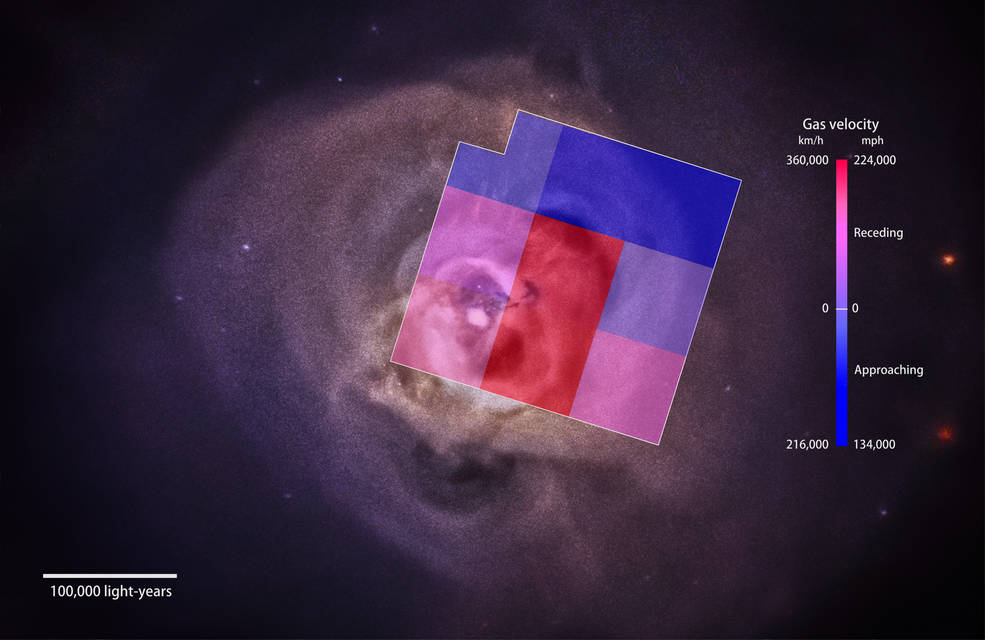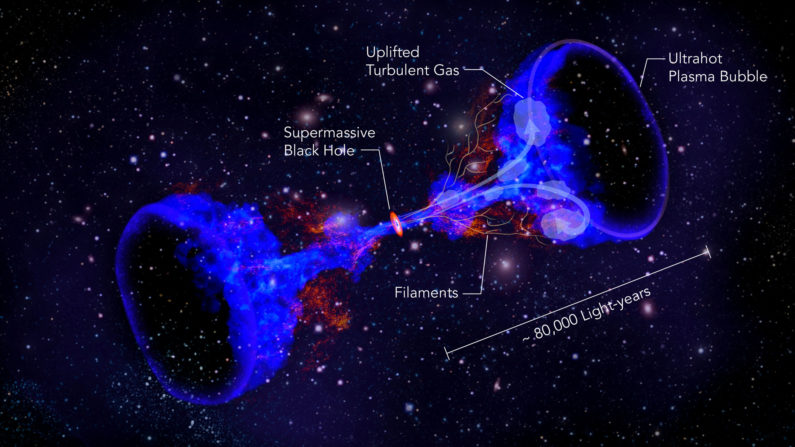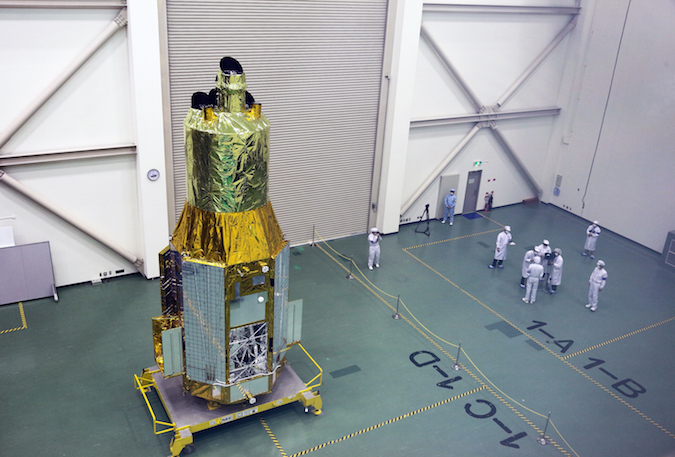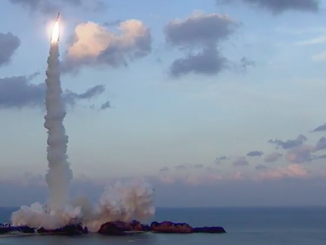
Credits: NASA Goddard and NASA/CXC/SAO/E. Bulbul, et al.
Japan’s doomed Hitomi observatory peeled back a veil on the inner workings of the Perseus cluster of galaxies before the satellite spun out of control earlier this year, revealing in unprecedented detail how gas heated to millions of degrees behaves around an unseen supermassive black hole, scientists said.
The Hitomi satellite gathered the observations for the discovery in just two-and-a-half days, before it succumbed to a chain of errors that led to the loss off the mission 26 March.
The results published in the 7 July edition of the journal Nature offer a tease of what the Hitomi observatory, billed by astronomers as the most important X-ray mission of the decade, could have discovered during its planned three-year mission led by the Japan Aerospace Exploration Agency.
Within weeks after its 17 February launch, Hitomi extended its optical bench and turned its X-ray sensors toward the Perseus cluster of galaxies, a section of the sky populated with thousands of galaxies and named for the constellation in which it appears.
The observations of the Perseus group with Hitomi’s Soft X-ray Spectrometer, an instrument developed at NASA’s Goddard Space Flight Center with contributions from scientists in Japan and the Netherlands, revealed a “remarkably quiescent atmosphere” around a supermassive black hole at the cluster’s core.
The quiet environment are the heart of the Perseus cluster — a vast structure 240 million light-years away — was a surprise to some scientists. A galaxy named NGC 1275 at the core of the cluster erupts in bubbles of gas into the space surrounding it.
“This cluster contains an active galaxy in its core, and there is clear evidence in previously obtained X-ray images that outflows from this ‘central engine’ have injected shocks and bubbles into the cluster core,” said Andrew Szymkowiak, a Yale senior research scientist in astronomy and physics and a member of the Soft X-ray Spectrometer, or SXS, development team. “The surprising result from the spectra obtained with the SXS is that the bulk of the X-ray gas only shows evidence for very small amounts of turbulence from these outflow events.”
NASA said the information collected by the SXS instrument yielded results 30 times better than previous X-ray spectral observations of the centre of the Perseus cluster. The measurements show the spectral signatures of metals like iron, nickel, chromium and manganese dispersed through countless stellar explosions, or supernovas.
“Being able to measure gas motions is a major advance in understanding the dynamic behavior of galaxy clusters and its ties to cosmic evolution,” said Irina Zhuravleva, a postdoctoral researcher at the Kavli Institute for Particle Astrophysics and Cosmology, a joint institute of Stanford University and the Department of Energy’s SLAC National Accelerator Laboratory.
The hot gas in the Perseus cluster shines bright in X-ray wavelengths, but is unseen in visible light. The temperature of the gas averages around 50 million degrees Celsius (90 million degrees Fahrenheit), scientists said.

“For the first time, we have mapped the motion of the X-ray-emitting gas in a cluster of galaxies and determined its velocity structure over a wide range of spatial scales,” said Richard Kelley, the U.S. principal investigator for the Hitomi collaboration at the Goddard Space Flight Center. “Although this gas is continually stirred by fast outflows from the central black hole, its velocities are small on astronomical scales and show evidence for only minor levels of turbulence.”
The SXS instrument aboard Hitomi was designed to study the composition and velocity of super-heated matter surround black holes. Astronomers expected the detector to send back unrivaled data about the complicated environment around the compact, collapsed skeletons of stars.
The sensor measured gas velocities toward and away from Earth within a total range of about 590,000 kilometres per hour (365,000 miles an hour), a “surprisingly modest” speed on cosmic scales, NASA said in a statement.
The result indicates that turbulence from the black hole contributes a small fraction of the total gas pressure in the region of the Perseus cluster observed by Hitomi, allowing astronomers to refine their estimate of the cluster’s mass.
“I’m surprised the hot gas is absorbing the power output of the black hole so quickly, so efficiently. The gas is relatively stable and isn’t getting pushed around as much as we thought,” said team member Brian McNamara, a professor of physics and astronomy at the University of Waterloo in Ontario. “Hitomi’s Perseus observation tells us that we can probably weigh distant galaxy clusters to greater accuracy than we can weigh our own Milky Way galaxy.”
Improved size and mass estimates for clusters of galaxies could help cosmologists better measure the growth and evolution of the most enormous structures in the Universe.
“Although the Hitomi mission ended tragically after a very short period of time, it’s fair to say that it has opened a new chapter in X-ray astronomy,” said Zhuravleva, a co-author of the study published in Nature.
The core of Hitomi’s X-ray spectrometer was a “microcalorimeter” unlike any successfully flown before. The researchers in charge of the instrument tried to fly it on a mission that eventually became NASA’s Chandra X-ray Observatory, but officials kept the spectrometer off Chandra due to budget concerns.

NASA partnered with Japan to launch the instrument on an X-ray observatory in 2000, but that mission was lost in a launch mishap. Japan’s follow-up X-ray telescope launched with a replacement NASA-built spectrometer in 2005, but the sensor failed before collecting science data.
The science team behind microcalorimeter technology now has to contend with another failure.
Chandra is the workhorse for astronomers pursuing research in those areas. Europe’s XMM-Newton space telescope is also an asset for X-ray astronomers. But both missions launched in 1999 and are functioning well beyond their designed lifetimes, and neither can resolve the composition and motion of hot gas as well as Hitomi.
The NuSTAR X-ray telescope developed by NASA is also available, but its sensor is also not as capable as the instruments lost aboard Hitomi.
Scientists may have to wait for the next large X-ray mission on the books. The European Space Agency-led Athena X-ray observatory is expected to launch in 2028, and it is the only project planned to fully follow up on Hitomi’s promise.
“Scientifically and technically, the Hitomi results are an exciting foretaste of Athena,” said David Lumb, ESA’s Athena study scientist, in a statement. “The demonstration of a radically new imaging spectrometer instrument concept gives huge confidence for future developments for Athena.”
Hitomi’s nearly $400 million mission abruptly ended 26 March, when a series of attitude control failures caused the satellite to spin out of control, leading to its partial break-up in Earth orbit.
The mission’s overall cost included $55 million from NASA for development and construction of the Soft X-ray Spectrometer.
“The data Hitomi sent back to Earth are just beautiful,” said Norbert Werner, a research associate at the Kavli Institute for Particle Astrophysics and Cosmology.
“They demonstrate what’s possible in the field and give us a taste of all the great science that should have come out of the mission over the years,” Werner said.
Email the author.
Follow Stephen Clark on Twitter: @StephenClark1.



